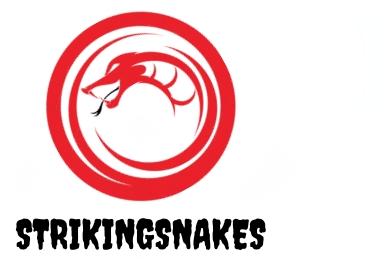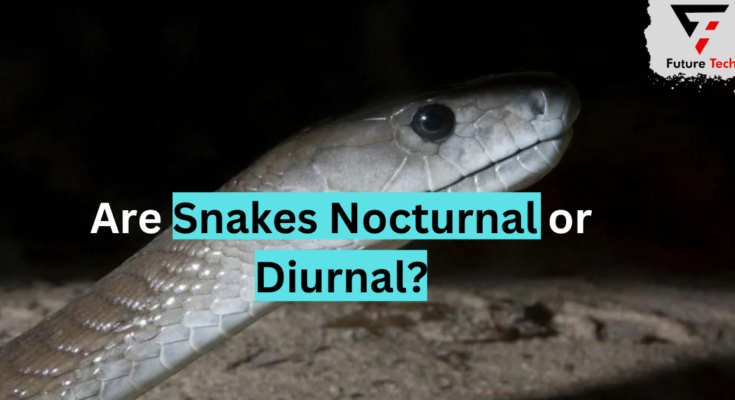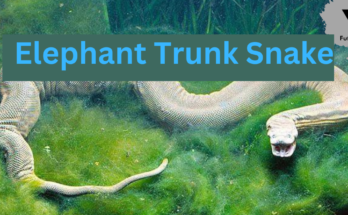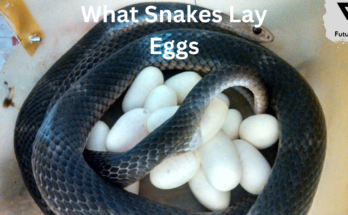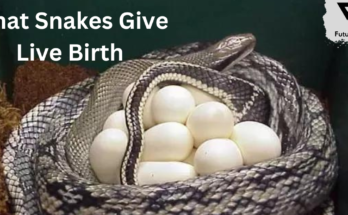Snakes are adaptive animals that constantly change to live using the available resources, much like most other living things. 50–45 million years ago, snakes were nocturnal predators who didn’t need much vision when they emerged. For this reason, the majority of them still have inferior ideas.
Many snake species have evolved to hunt during the day to live through evolution and the many changes the Earth has seen, while other snake species have continued to be nocturnal. It is known that these seven snakes hunt at night.
Different Species of Snakes Have Different Sleeping Habits
There are snake species that are crepuscular, nocturnal, or exclusively diurnal. For instance, a ball python is nocturnal, a corn snake is crepuscular, and a black mamba is diurnal. For various reasons, snakes may be nocturnal, crepuscular, or daily. Some have a genetic background that makes them inherently active at certain times. Others, however, have had to modify their sleeping patterns due to dietary availability, environmental factors, and possible threats. Different animals also have different sleep cycles in terms of duration.
Snakes That Sleep at Night
Ball pythons get 20 to 23 hours of sleep every day. This snake is nocturnal by nature. Therefore, it spends the bulk of the day sleeping. The ball python’s sleeping habits are characteristic of more sluggish ambush predators. Ball pythons eat by swallowing their prey whole, much like other snakes. This eating pattern makes it necessary for the digestive system to take longer to process the food completely. Ball pythons use a great deal of energy throughout this process, and for the most part, they sleep.
Five Night Hunting Snakes
1. Serpentines Snakes
The rattlesnake is well-known for both its venom and its distinctive rattle in many parts of the world, making it one of the most popular pit vipers. Even though they are active at all times, these snakes prefer to hunt at night when many of their nocturnal prey are out and about. Because of their pit organs, which enable infrared detection, pit vipers can detect movements in their target. Jacobson’s organs enhance their hunting capabilities by tasting molecules in the air, which helps them assess their environment in addition to their infrared sense. These qualities make nocturnal hunting for these snakes relatively straightforward.
As ambush predators, rattlesnakes lurk in peaceful waiting areas for their intended meal. They wait for their victim to get near enough for them to strike while hiding out of sight. Their ability to surprise their victim enables them to attack with lethal poison in their long, sharp solenoglyphous fangs. The rattlesnake quickly renders its victim immobile with its venom, and it then devours it.
2. Slack mouths
Cottonmouths are a pit viper that is nocturnal and hunts prey on the ground. They are skilled nocturnal hunters because they have pit organs, which allow them to detect motion and assess their environment, even without their eyes. Poisonous and much more deadly predators are cottonmouths. The venom of a cottonmouth may be lethal to people and highly harmful.
3. Constrictors Boa
Large constrictors known as boas are often seen throughout Southern America. Being nocturnal animals, they hunt best at night. They mainly eat giant lizards, birds, rodents, and medium-sized animals. The rumor mill claims that boa constrictors will eat everything from pigs to monkeys. Being ambush hunters, these snakes wait for their victim to attack. They could, nonetheless, decide to engage in active hunting in regions with little or no prey.
In either case, the boa’s first action is to seize its meal with its fangs before encircling it with its body. The prey tightens its grip, preventing its victim from exhaling when it inhales or draws air. This causes the victim to lose consciousness and cease breathing, making it possible for the boa constrictor to devour it whole.
Cannibalistic, these semi-aquatic snakes feed on fish, mice, rats, frogs, tiny nocturnal animals, smaller snakes, and even other cottonmouths. Often referred to as water moccasins, they encircle their victim until they quit squirming and fighting after striking them once with their poisonous blow. They then ingest their victim. Juveniles, or baby cottonmouths, approach things differently. They have brightly colored tails from birth, which they wag like worms. They entice gullible frogs and toads with this.
4. Vipers of Gaboon
Despite their lethal venom, gaboon vipers are dangerous snakes that agitate slowly. They consume birds, amphibians, and tiny to medium-sized animals as food. This species has been seen killing and eating fully mature royal antelopes. Gaboon vipers only engage in active hunting during the wee hours of the morning. They may also engage in ambush hunting.
These lethal vipers move slowly and may seem ponderous, yet their strikes are among the fastest in the world. Not only are their blows fatal, but they also happen quickly and precisely. The giant snake teeth of any species belong to the gaboon viper, and they cling to their victim tightly. They pierce their victim with their lethal poison and remain there till the victim passes away. They then ingest their kill in its entirety.
5. Night Snake
As their name suggests, night snakes are nocturnal animals. They are, nonetheless, also crepuscular, active at dawn and twilight. They lack rattles, although they resemble rattlesnakes in appearance. The fact that female night snakes are sometimes up to three times heavier and twice as long as males is another significant distinction between the two species. Rear-fanged colubrids, or “night snakes,” are native to Mexico and the western United States.
These snakes are poisonous, and they hunt for lizards at night to feed on. The venom of night snakes is tailored to target their prey mainly and is safe for people to consume. Because their poison immobilizes their victim, they can swallow objects that are larger than their heads. Night snakes often take refuge in crevices among rocks and dead vegetation when they are not actively searching.
Snake Sleeping Habits: Whether They’re Nocturnal or Not
Both slow-wave and REM sleep are possible for snakes. Snakes’ brain activity rises, and their sleep becomes shallower as they go into REM sleep. Snakes in this slumber state cannot move their massive muscles because they are temporarily paralyzed. Usually, an hour and a half after they fall asleep, they experience REM sleep. A whole ten minutes or so make up the initial REM stretch. The length of each REM session that follows increases. Snakes are most peaceful during slow-wave sleep, sometimes called deep slumber. EEG monitoring shows synchronized activity and sluggish brain waves during deep sleep. Snake muscles relax, and heart and respiration rates drop during this time.
The Way a Diurnal Snake Sleeps
Large and nocturnal, the black mamba snake is found in sub-Saharan Africa. These poisonous snakes sleep primarily at night when they retreat to secure hiding spots away from people and other predators. These snakes begin to be active in the morning. Their cold-blooded constitution and need for the sun’s heat to regulate their bodies are the causes of this behavior. When the weather becomes too hot, these snakes may seek shelter and go dormant. Instead, they search for rocks and sunny spots to sunbathe in.
Due to their superior vision, black mambas can locate and follow their prey more easily when hunting. They also have a highly developed sense of smell. During the breeding season, this and other snake species employ this sense essentially to find females.
Eyelids in Place of Brilles
Because ball pythons have “brille” eyes instead of eyelids, it might be challenging to determine whether they are sleeping. The layer of skin covering the eyes, known as the bridles, is invisible to the naked sight. Due to their sensitivity to UV radiation, ball pythons are nocturnal creatures that spend much of their time in gloomy environments. Unlike their night vision, their daylight eyesight could be better. In addition to making daylight activities difficult due to poor eyesight, they are also capable of sensing infrared heat radiation. These reptiles have exceptional night vision thanks to this sense and their sensitivity to UV light.
The Sleeping Patterns of Crepuscular Snakes
Corn snakes are crepuscular, meaning they are active at dawn and dusk. Typically, wild corn snakes sleep in two cycles. They will only follow their regular processes while maintained as pets by people if they feel at ease in their surroundings. Twice a day, corn snakes are active. They wake up around daybreak and start their first sleep cycle before they go hunting. Following their meal and finding a spot to hide, corn snakes will slumber until sunset. Keep an eye on your pet corn snakes’ sleep if you have any. Your snake is only at ease in its environment if participating in these two cycles. To help their snake feel secure and at ease in its cage, owners should create a tranquil atmosphere with dim lighting.
Not a lid
Since corn snakes lack eyelids, many people are curious about how they sleep. All creatures, including corn snakes, need to sleep for their brains to relax, whether they are nocturnal or not. It may be challenging to determine whether a snake is aware since they can sleep with their eyes “open.” However, cornsnakes seal their retinas when they sleep. Put differently, the retinas shield their eyes from light. People with closed retinas were blind, even if their eyes seemed open. As a result, a snake is most likely sleepy if it is not flicking its tongue or if it remains still for a long time. Your corn snake is most likely in a deep slumber if it is still and does not respond when you open the cage cover.
Snakes Sleep Where?
Snakes like to sleep in concealed or safe places away from crafty predators. Nevertheless, the species determines where they will sleep. Vine snakes live in woodlands, whereas water snakes live near water. On the other hand, snakes like to sleep in certain places and structures. Snakes like to sleep under giant boulders, and you may often see them asleep or relaxing under them. Under logs, branches, caves, and abandoned structures, snakes find refuge and rest.
Snakes Don’t Always Sleep in the Same Spot
Because they choose diverse spots to rest while out in the wild, snakes are difficult prey for predators to catch. These reptiles have to evade predators since certain animals seek snakes deliberately. But certain snakes, like timber rattlesnakes, undergo brumation, akin to hibernation when they return to their birthplace once a year. During the winter months, many snakes brumate and might become completely motionless.
Typically, these creatures locate their winter quarters in secluded regions of the wild, away from disturbances. In the natural, caves, cracks, leaf litter, and shelters are all great sites for snakes to breathe. Certain temperate species may even submerge in water. In addition, these timber rattlesnakes allow many snakes to share their resting areas. For example, the timber rattlesnake may share its sleeping area with racer snakes.
In winter, where do snakes sleep?
Winter brings sharp drops in temperature along with days of freezing rain and snow. Snakes are rare this time of year. The primary explanation is that these reptiles are lethargic in temperatures below sixty degrees Fahrenheit. Snakes cannot live in the winter since it may be as low as minus 70 degrees Fahrenheit for extended periods. Because of this, snakes hibernate for a few weeks to four months. Bermation is a similar activity to hibernation that helps cold-blooded animals weather-proof themselves. Snakes brumate in hibernacula or shelters.
Conclusion
Snakes have various sleeping habits, including slow-wave and REM sleep. Black mamba snakes are giant and nocturnal, sleeping primarily at night when they retreat to secure hiding spots away from people and predators. Ball pythons get 20 to 23 hours of sleep daily, being nocturnal and having exceptional night vision due to their sensitivity to UV radiation.
Corn snakes are crepuscular, active at dawn and dusk, sleeping in two cycles. They wake up around daybreak and start their first sleep cycle before hunting. After their meal, they slumber until sunset. To keep their snakes at ease, owners should create a tranquil atmosphere with dim lighting.
